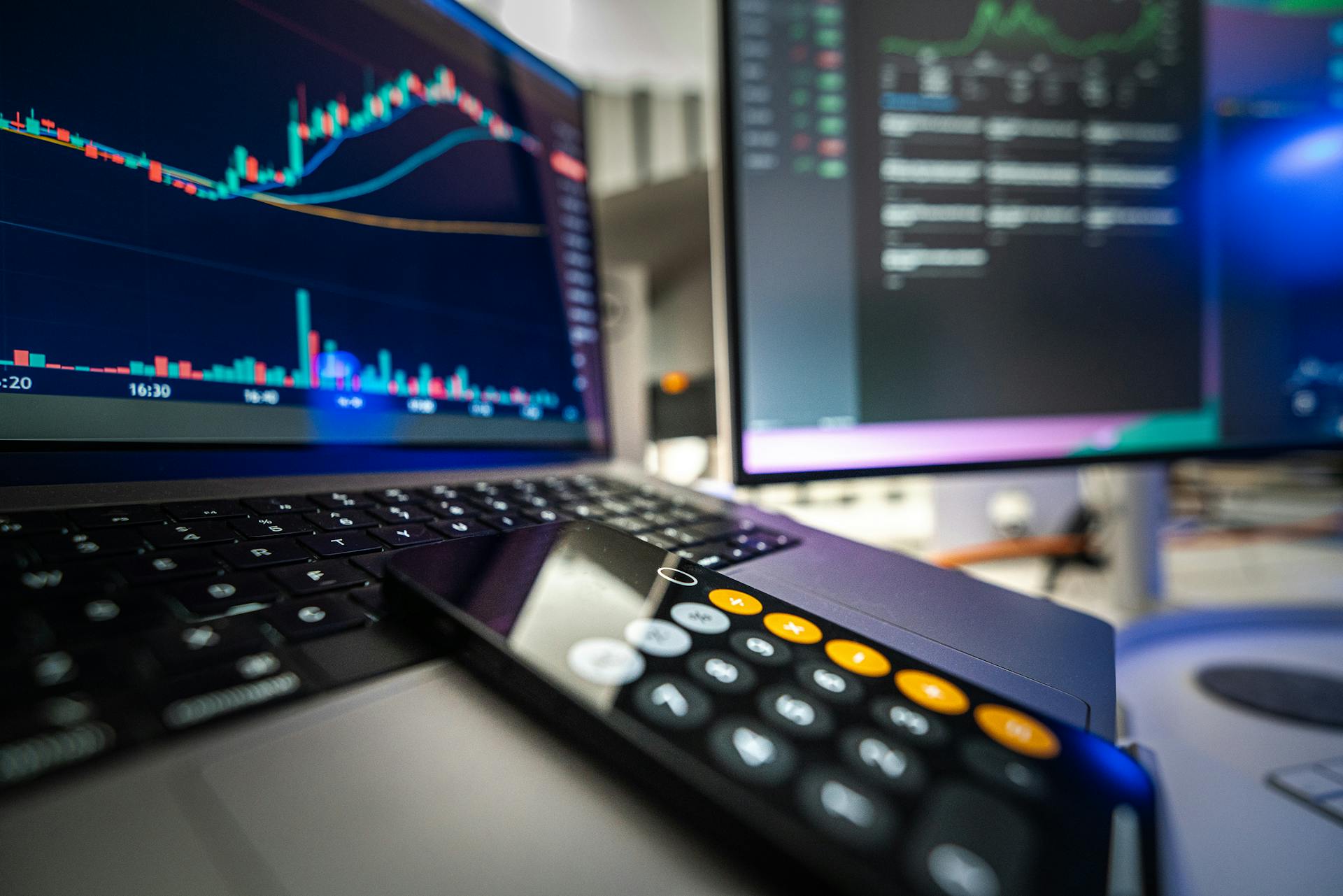
Demand deposits are a type of bank account that allows you to write checks or use a debit card to access your money.
In the M1 money supply, demand deposits are included as they are easily accessible and can be spent quickly.
M1 includes coins and currency in circulation, plus demand deposits, which are essentially the money in checking accounts.
This makes M1 a good indicator of the money that's readily available for spending in the economy.
US and International Definitions
In the United States, the Federal Reserve provides two main measures of money – M1 and M2. M1 is the narrowest measure, consisting of currency in circulation, travelers’ checks of nonbank issuers, demand deposits, and other checkable deposits.
The European Central Bank, on the other hand, provides three measures of money – M1, M2, and M3. M1 consists of currency in circulation plus all overnight deposits.
M2 is a broader measure of money, including all the items in M1, plus deposits redeemable at notice of up to three months and deposits with an agreed maturity of up to two years. This is also true for the European Central Bank's M2 measure.

M3, the broadest measure, includes all the items in M2, plus repurchase agreements, money market fund shares, money market paper, and debt securities issued with a maturity of fewer than two years. This is also the case for the European Central Bank's M3 measure.
Here's a comparison of the US and European measures of money:
Key Concepts and Measures
Money is a complex concept with multiple definitions. M1 includes currency and money in checking accounts (demand deposits), while M2 includes all of M1, plus savings deposits, time deposits, and money market funds.
M1 is a key component of the money supply, and it's used by consumers in everyday transactions. Traveler's checks, though declining in use, are also a part of M1.
The total amount of money circulating in an economy is called the money supply. It's tracked and reported publicly by each country's central bank or government.
Narrow money refers to the group of money that includes bills, coins, and bank deposits that can be used for transactions. This is in contrast to broad money, which includes all the items in narrow money, plus other liquid assets.
Broad money is a broader measure of money supply, taking into account not just the traditional forms of money, but also other liquid assets that can be used to buy goods and services.
National and Regional Definitions
Central banks around the world use measures of money that vary from country to country. These measures are usually identified by an M followed by one or more digits, and sometimes a letter.
The Federal Reserve in the United States provides two main measures of money – M1 and M2. The distinction between these measures is mainly theoretical, but they are used to track different aspects of the money supply.
Definitions in Australia
In Australia, the Reserve Bank uses three main measures of money: M1, M3, and Broad Money. M1 is the narrowest measure, consisting of coins and bills in circulation plus bank current deposits from private non-bank entities.
M1 includes coins and bills in circulation, plus deposits, which gives you an idea of the most liquid form of money in circulation. M1 is a crucial measure of money in Australia.
M3 is a broader measure that includes all the items in M1, plus other deposits from building societies and credit unions with banks. This measure gives a more comprehensive view of the money supply in Australia.

Here's a breakdown of the different measures of money in Australia:
Broad Money is the broadest measure of money in Australia, giving a comprehensive view of the money supply.
National Definitions
National definitions of money vary from country to country, but they all use some form of measure for narrow and broad money.
In the United States, the Federal Reserve provides two main measures of money – M1 and M2. M1 is the narrowest, consisting of currency in circulation, demand deposits, and other checkable deposits.
The M1 measure is the same in other countries, consisting of currency in circulation plus overnight deposits. This is the most liquid measure of the money supply.
M2 is also a widely used measure, including all the items in M1, plus savings deposits and money market deposit accounts. This measure is also used in other countries, including deposits with an agreed maturity up to two years and deposits redeemable at a period of notice up to three months.

Here's a list of the different M measures used in various countries:
- M1: Currency in circulation plus overnight deposits
- M2: M1 plus deposits with an agreed maturity up to two years plus deposits redeemable at a period of notice up to three months
- M3: M2 plus repurchase agreements plus money market fund (MMF) shares/units, plus debt securities up to two years
M3 is the broadest measure of money used in some countries, including deposits that are not included in M2. This measure is not as widely used as M1 and M2, but it still provides valuable information about the money supply.
Supply and Demand
Supply and Demand plays a crucial role in determining the money supply in an economy.
M1, which includes demand deposits, is a key component of the money supply. This is because demand deposits are liquid assets that can be easily converted into cash.
In the United States, the Federal Reserve uses a monetary policy framework that targets the growth rate of M2, which includes M1, to manage the money supply.
The money multiplier formula is M1 x (1/Reserve Requirement) = Money Supply. This formula shows how changes in M1 can affect the overall money supply.
The money multiplier is influenced by the reserve requirement ratio, which is set by the Federal Reserve. A lower reserve requirement ratio allows banks to lend more, increasing the money supply.
Take a look at this: Federal Recurring Deposit
Frequently Asked Questions
How to tell if something is M1 or M2?
To determine if a type of money is M1 or M2, check if it's very liquid, such as cash or checkable deposits, or if it's less liquid, like savings accounts or certificates of deposit. If it's highly liquid, it's likely M1, while less liquid options are probably M2.
Does M1 include net demand deposit?
Yes, M1 includes net demand deposits. Net demand deposits are a key component of the M1 monetary aggregate.
Does M2 include bank deposits?
Yes, M2 includes savings deposits in banks, which can be withdrawn at an ATM or bank. These deposits are a type of bank account that can't be accessed with a check.
Sources
- https://corporatefinanceinstitute.com/resources/career-map/sell-side/capital-markets/definitions-of-money/
- https://pressbooks-dev.oer.hawaii.edu/principlesofeconomics/chapter/27-2-measuring-money-currency-m1-and-m2/
- https://en.wikipedia.org/wiki/Money_supply
- https://ecampusontario.pressbooks.pub/principlesofmacroeconomicscdn/chapter/10-3-measuring-money-m1-and-m2/
- https://www.richmondfed.org/publications/research/econ_focus/2019/q1/jargon_alert
Featured Images: pexels.com


